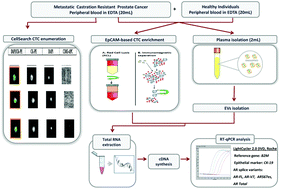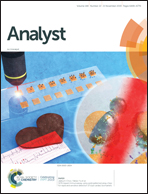Expression pattern of androgen receptors, AR-V7 and AR-567es, in circulating tumor cells and paired plasma-derived extracellular vesicles in metastatic castration resistant prostate cancer†
Abstract
Androgen-receptor splice variant 7 (AR-V7) is a highly promising liquid biopsy predictive biomarker showing primary or acquired resistance to novel androgen receptor signaling inhibitors in metastatic castration resistant prostate cancer (mCRPC). We present for the first time the expression pattern of AR-FL, AR-V7, and AR-567es at a quantitative level in circulating tumor cells (CTCs) and paired plasma-derived extracellular vesicles in mCRPC. We first developed and analytically validated a novel multiplex RT-qPCR assay for AR full length (AR-FL), AR-V7, AR-567es and AR-total. We then quantified the expression levels of AR-splice variants, CK-19 (epithelial marker) and B2M (reference gene) in EpCAM+ CTCs, and paired plasma-derived extracellular vesicles isolated from peripheral blood (20 mL) of 62 mCRPC patients and 10 healthy donors. CTCs were enumerated using the FDA-cleared CellSearch® system. In CTCs AR-FL was detected in 64/69 (92.3%), AR-V7 in 34/69 (49.3%), AR-567es in 16/69 (23.2%) and AR-total in 62/69 (89.9%). In 52 out of 69 samples, paired plasma-derived extracellular vesicles were analyzed. AR-FL was detected in 40/52 (76.9%), AR-V7 in 4/52 (7.7%), AR-567 in 2/52 (3.8%) and AR total in 39/52 (75.0%). In all cases AR splice variants were expressed in higher levels in CTCs than in paired extracellular vesicles, while AR-V7 was detected in higher percentages than in AR-567es. Using CellSearch®, CTCs were detected in 52/69 (75.4%) mCRPC patient samples; 27/52 (51.9%) of these samples were CTC+/AR-V7+ and 14/52 (26.9%) were CTC+/AR-567es+, while 7/17 (41.2%) were CTC-/AR-V7+ and 2/17 (11.8%) were CTC-/AR-567es+. Our results reveal for the first time a remarkable heterogeneity in the expression levels of AR-FL, AR-V7 and AR-567es in EpCAM+ CTCs and paired extracellular vesicles between individual mCRPC patients. The clinical significance of this finding will be further investigated in a large patient cohort with respect to therapy response.

- This article is part of the themed collection: Bioanalytical tools for enabling precision medicine


 Please wait while we load your content...
Please wait while we load your content...